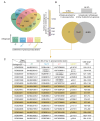A Lateral Flow-Recombinase Polymerase Amplification Method for Colletotrichum gloeosporioides Detection
- PMID: 38786670
- PMCID: PMC11121841
- DOI: 10.3390/jof10050315
A Lateral Flow-Recombinase Polymerase Amplification Method for Colletotrichum gloeosporioides Detection
Abstract
The greater yam (Dioscorea alata), a widely cultivated and nutritious food crop, suffers from widespread yield reduction due to anthracnose caused by Colletotrichum gloeosporioides. Latent infection often occurs before anthracnose phenotypes can be detected, making early prevention difficult and causing significant harm to agricultural production. Through comparative genomic analysis of 60 genomes of 38 species from the Colletotrichum genus, this study identified 17 orthologous gene groups (orthogroups) that were shared by all investigated C. gloeosporioides strains but absent from all other Colletotrichum species. Four of the 17 C. gloeosporioides-specific orthogroups were used as molecular markers for PCR primer designation and C. gloeosporioides detection. All of them can specifically detect C. gloeosporioides out of microbes within and beyond the Colletotrichum genus with different sensitivities. To establish a rapid, portable, and operable anthracnose diagnostic method suitable for field use, specific recombinase polymerase amplification (RPA) primer probe combinations were designed, and a lateral flow (LF)-RPA detection kit for C. gloeosporioides was developed, with the sensitivity reaching the picogram (pg) level. In conclusion, this study identified C. gloeosporioides-specific molecular markers and developed an efficient method for C. gloeosporioides detection, which can be applied to the prevention and control of yam anthracnose as well as anthracnose caused by C. gloeosporioides in other crops. The strategy adopted by this study also serves as a reference for the identification of molecular markers and diagnosis of other plant pathogens.
Keywords: Colletotrichum gloeosporioides; Dioscorea alata; disease diagnosis; pathogen identification; primer development.
Conflict of interest statement
The authors declare no conflicts of interest.
Figures





Similar articles
-
Polymerase chain reaction assay for rapid, sensitive detection, and identification of Colletotrichum gloeosporioides causing greater yam anthracnose.Mol Biotechnol. 2012 Nov;52(3):277-84. doi: 10.1007/s12033-012-9496-9. Mol Biotechnol. 2012. PMID: 22315088
-
Visualized Detection of Tobacco Anthracnose by a Recombinase Polymerase Amplification-Lateral Flow Dipstick Assay.Plant Dis. 2024 Dec;108(12):3614-3622. doi: 10.1094/PDIS-07-24-1382-RE. Epub 2024 Dec 5. Plant Dis. 2024. PMID: 39146007
-
Genome Sequence Resource for Colletotrichum gloeosporioides, an Important Pathogenic Fungus Causing Anthracnose of Dioscorea alata.Plant Dis. 2023 Mar;107(3):893-895. doi: 10.1094/PDIS-03-22-0567-A. Epub 2023 Mar 20. Plant Dis. 2023. PMID: 36265140
-
Molecular Detection of QoI Resistance in Colletotrichum gloeosporioides Causing Strawberry Anthracnose Based on Loop-Mediated Isothermal Amplification Assay.Plant Dis. 2019 Jun;103(6):1319-1325. doi: 10.1094/PDIS-09-18-1593-RE. Epub 2019 Apr 18. Plant Dis. 2019. PMID: 30998417
-
Foliar Application of Extract from an Azalomycin-Producing Streptomyces malaysiensis Strain MJM1968 Suppresses Yam Anthracnose Caused by Colletotrichum gloeosporioides.J Microbiol Biotechnol. 2016 Jun 28;26(6):1103-8. doi: 10.4014/jmb.1601.01018. J Microbiol Biotechnol. 2016. PMID: 26975770
References
-
- Wang P., Shan N., Ali A., Sun J., Luo S., Xiao Y., Wang S., Hu R., Huang Y., Zhou Q. Comprehensive Evaluation of Functional Components, Biological Activities, and Minerals of Yam Species (Dioscorea polystachya and D. alata) from China. LWT. 2022;168:113964. doi: 10.1016/j.lwt.2022.113964. - DOI
-
- Lebot V., Lawac F., Legendre L. The Greater Yam (Dioscorea alata L.): A Review of Its Phytochemical Content and Potential for Processed Products and Biofortification. J. Food Compos. Anal. 2023;115:104987. doi: 10.1016/j.jfca.2022.104987. - DOI
-
- More S.J., Ravi V., Raju S., de Freitas S.T., Pareek S. Tropical Tuber Crops. Volume 1. CRC Press; Boca Raton, FL, USA: 2019. pp. 719–758.
-
- Agre P.A., Darkwa K., Olasanmi B., Kolade O., Mournet P., Bhattacharjee R., Lopez-Montes A., De Koeyer D., Adebola P., Kumar L., et al. Identification of QTLs Controlling Resistance to Anthracnose Disease in Water Yam (Dioscorea alata) Genes. 2022;13:347. doi: 10.3390/genes13020347. - DOI - PMC - PubMed
Grants and funding
LinkOut - more resources
Full Text Sources

